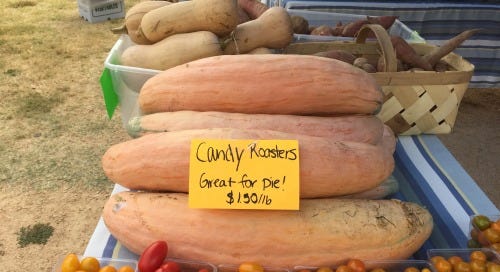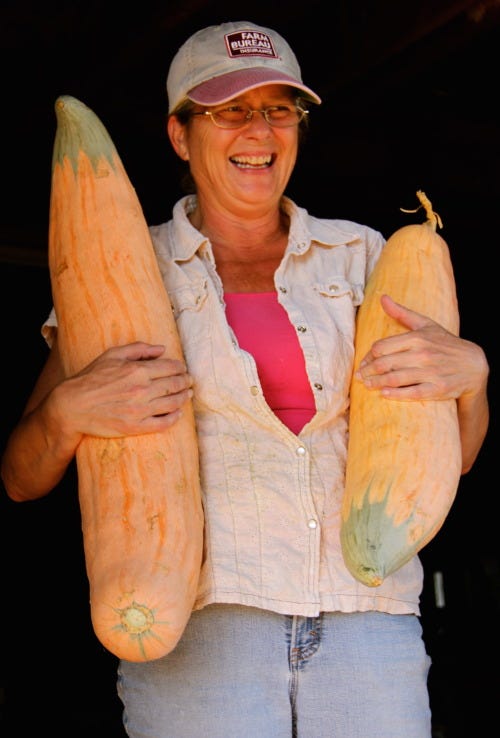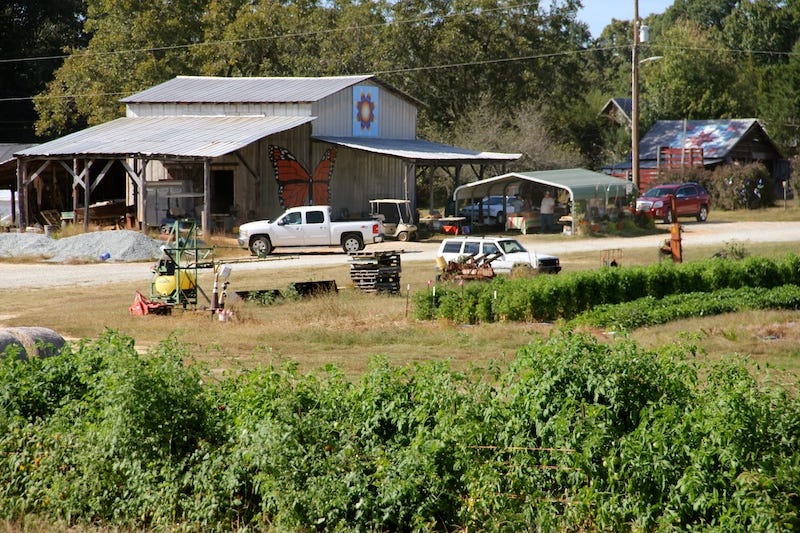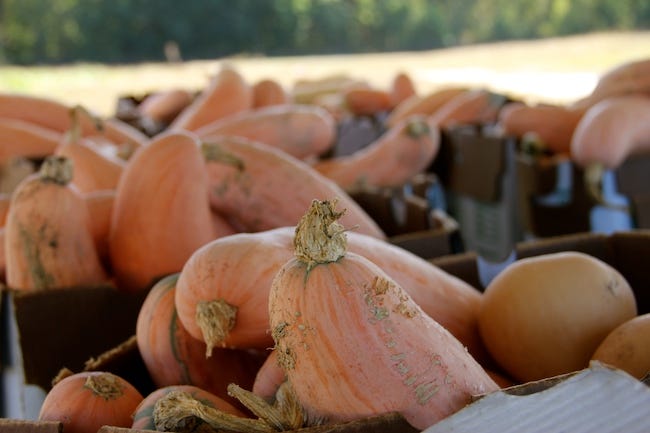It’s pepper and pumpkin season here in the North Carolina Piedmont.
Last Saturday, during our weekly pilgrimage to the Carrboro Farmer’s Market, Donna Campbell and I were, as usual, caught in the slow-rolling jam of cars seeking a parking place. Two women walked single file toward us, their arms already loaded with homegrown provisions. We edged toward them, hoping to snag the spot they’d leave open. The woman in front raised her key fob and the maw of a nearby blue hatchback opened. She unloaded her bags of produce. Then the second woman stepped up with what, I swear, looked like plus-sized mannequin thighs–one in each arm. She gently laid them into the back of the car. Donna rolled down the window. “What was that?” she hollered.
“Candy Roasters. We’ve been looking for them all over,” Both women grinned with delight. “They are better than pumpkin in pie.”
At the Carrboro Farmers Market the first weekend in October. Photo by G. Eubanks
And so began our investigation into a rare heirloom squash, much beloved and anticipated each autumn by those who know them.
The Candy Roaster is a member of the diverse Curcurbita genus, which includes many of the domesticated fruits we know as pumpkins, gourds, and squash. These plants likely originated in South America more than 4,000 years ago, according to the National Academy of Sciences. Cultivars in the Curcurbita Maxima group include Hubbard, Turban, Buttercup, and Pink Banana squash. All are considered winter squash and store well through the season. The variety known as the Candy Roaster, however, was developed by the Cherokee Indians in southern Appalachia, experts say.
This heirloom variety can range from fewer than 10 pounds on up to 250 pounds! The Candy Roaster was traditionally grown by the Cherokee people in the “Three Sisters” method. In this scheme a stalk of corn provides a stake for a pole bean plant which, in turn, takes nitrogen from the air and fixes it in the soil for nourishment. At the same time, squash vines planted at the base help deter weeds surrounding all three.
According to the Office of the Chief of the Cherokee Nation, the Candy Roaster is among a number of heirloom plants that the tribe is now protecting for posterity. The seeds are fastidiously preserved in the Cherokee Nation Seed Bank and are made available in limited quantities each year to enrolled members of the tribe. The official Cherokee name for these seeds is the “Georgia Candy Roaster."
Elsewhere, depending on geography, the squash may carry the appellation "Great Smoky Mountain” or “North Carolina” ahead of the Candy Roaster name. There are also name variations that relate to coloration–blue, green, green and white striped. However, as best as I can tell, the most likely variety to be found in North Carolina markets these days is the long, orangish variety we found in Carrboro, simply because these seeds are commercially available to growers from several suppliers.
According to an extensive study of Appalachian heirloom vegetables conducted by the RAFT Alliance (Renewing America’s Food Traditions), the true North Carolina Candy Roaster is already extinct, and the North Georgia Candy Roaster is threatened. I am guessing that all of these variations in name were partly created by geographic pride and otherwise may be the result of cross pollination leading to somewhat different progeny over the years. According to SlowFood USA, the Curcurbita Maxima can cross pollinate with other squash and must be protected against drifting winds if pure, heirloom seeds are to be harvested for collection.
After corresponding with my friend, the ace high school English teacher and novelist, Annette Saunooke Clapsaddle from Cherokee, I wished we’d had time to drive west to the annual Cherokee Fair which is going on at the time of this post, and where, Annette said, we’d be sure to find vendors offering the Candy Roaster, presumably grown from tribal seeds.
After we bought a couple of the leggy squash that day at Carrboro Market, Donna and I decided to visit their source–McAdams Farm about 15 miles northwest in Efland, North Carolina. We’d hoped to photograph the 25-foot-long vines they grow on, but Howard and Karen McAdams had already harvested their entire yield for the season.
Two of the largest Candy Roasters in the McAdams’ Farm harvest this year.
“We get them up before they get all mildewy and slate-y,” Howard told us. He stored them in an open shed in cardboard produce boxes. They procure their seeds each year from Johnny’s Seed catalog, which often sells out very quickly.
The McAdams’ operation is an economic success story. In 2000 the family converted from tobacco, cotton, and corn to strawberries, vegetables, cut flowers, beef, and lamb. Their gently rolling, Alamance County land, in the family since 1885, has alternating patches of red clay and sandy white soil. Karen, a former Orange County agricultural extension agent, told us, “I always say to Howard how I can’t believe his family has farmed this poor dirt for all these years with so much yield."
McAdams’ Farm in Efland, North Carolina
Howard laughed. “Yeah, when it rains here and then dries out, you’d think we were making brick, not farming.”
Instead of mud pies, however, we aim to make Thanksgiving dessert from McAdams’ Candy Roasters. According to many enthusiastic, on-line endorsements from home cooks across the region and as far away as Ohio, the prized flesh of the Candy Roaster is not tough and stringy like pumpkin and is naturally very sweet, moist, and buttery. Recipes for pies are pretty easy to find on the Internet. Despite the innate sweetness, however, most of these recipes call for sugar–between a third and a three quarters of a cup. (Even Appalachian food maven Ronni Lundy suggests a drizzle of sorghum when pieces of Candy Roaster are eaten like a sweet potato.)
The first step to any pie recipe, however, is to cut the Candy Roaster longwise into halves, remove the seeds, and then slice them again into shorter-length pieces to fit in baking dishes or a roasting pan. Baked at a minimum of 375 degrees until tender, the skin should be a bit charred and the flesh juicy when done. Experts recommend freezing the scooped out flesh after it cools and transferring it into plastic freezer bags or mason jars for use throughout the season. It only takes two cups of puree for a pie.
How you choose to season the pie filling is a matter of personal taste. Some recipes call for cinammon, cloves, allspice, even raisins–the expected additions to bland pumpkin, which is always amenable to improvement. In 1897, Lady Llanover, the harpist and Welsh preservationist offered her damning praise of pumpkin with these ideas:
Pumpkins have one peculiar quality in addition to a good deal of natural sweetness; they will absorb and retain the flavour of whatever they are cooked with. If stewed with plums it tastes exactly like them in puddings and tarts; the same with apples, rhubarb, or gooseberries; and for savory cookery it would be difficult to say in what dish it may not be used with advantage as an addition.
When we make our pies next month from these enormous squash, I plan to eschew the sugar for starters to sample the true taste. As the Cherokee Chief’s document suggests, the Candy Roaster “can be prepared as squash, sweet potatoes, or pumpkin.“ So there’s room for lots of experimentation. Like the Butternut, this squash apparently pairs well with chile, cumin, and coriander for soups and other savory dishes. I have found recipes for Candy Roaster Chili (with chicken) from the North Carolina Folklife Institute and Candy Roaster Butter from another source.
Ronni Lundi confirms in her recent book Victuals that, “the Candy Roaster will intensify in flavor and density of flesh the longer you store the fresh squash.” So hang on, dear reader. After Thanksgiving, we’ll report the results of our Candy Roaster pies and a few other dishes.








